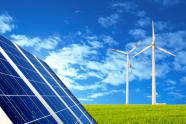Hawaii is Baking Up a lot of Wind and Sun
A green lab, say some

If you wanted to create a laboratory for clean
energy, you might pick these attributes: an isolated
market; one that’s almost wholly dependent on fossil
fuels; and it has abundant wind and sun. One such
lab already exists. It’s called Hawaii.
The archipelago is dependent on power generated by
diesel fueled power plants supplied by the
mainland, and now has embarked on an aggressive
campaign to produce its own energy, using wind and
solar, with a little geothermal and biomass kicked
in. And it has the most ambitious renewable
portfolio standard, long-term, that even tops
California’s.
There is some urgency in getting more home-grown
energy onto the grid, with costs mostly north of 40
cents per kilowatt-hour, and susceptible to spikes
in oil prices. Hawaii has set in law the most
aggressive clean energy goals in the nation: 70
percent clean energy for surface transportation and
electricity by 2030.
Energy Central recently spoke to Scott Seu, Vice
President of Energy Resources for Hawaiian Electric
Company,about their ongoing efforts.
Currently at 9 percent, the next milestone is for 15
percent by 2015.
“We expect that we're going to be on track for 2015
and 2020, when we’re to be at 25 percent renewables,
and in 2030 we need to get 40 percent, so we feel
pretty confident,” he said.
“Our rooftop solar program has exploded in the last
couple years,” Seu said.
A recent Public Utilities
Commission decision for a solar feed-in tariff was
approved, a decision HECO has been waiting for that
gives an incentive for large-scale projects.
The islands offer another unique set of challenges
not experienced on the mainland. Add a 30-megawatt
wind project to any other state and it’s a blip in
the generation portfolio of a system. In Maui, with
a baseload of about 200 megawatts, adding 30
megawatts becomes a major generator.
“When there is a small overall electric system, the
impact of a renewables project could have even more
of an effect. It almost becomes a micro grid,” he
added.
Oahu, the largest demand in the system, has a power
demand of about 2,000 megawatts. A federal study
earlier this year contemplated scenarios for a
successful integration of 500 megawatts of wind
through a combination of sites on the island and
connections with wind facilities on other islands.
Hawaii currently has 93 megawatts of wind and HECO
just recently signed a power purchase agreement with
First Wind for another 69-megawatt project on Oahu.
Other highlights include of renewables on the
islands include:
• Hawaiian Electric’s new,
biodiesel-powered generating station at Campbell
Industrial Park on Oahu is the first utility-scale
combustion turbine run entirely on biodiesel.
• Hawaiian Electric is
fast-tracking the adoption of electric vehicles in
Hawaii, by discounting rates and integrating
photovoltaic panels, a battery storage system and an
electric vehicle charger, which allows customers to
renewably charge vehicles 24 hours a day, seven days
a week.
• Hawaiian Electric is expanding
its use of geothermal power to 38 MW and is
exploring ways to further increase the use of
geothermal power.
• Hawaiian Electric spearheaded a
solar water-heating program decades ago, and now one
in four Hawaii rooftops have solar panels. The
company also ranks third in the nation in adding
solar photovoltaic watts per customer.
• Hawaiian Electric is developing
three major smart grid research projects on Maui, to
improve outage detection, make possible pricing
programs that can help customers save money, and
test ways to reliably integrate variable renewable
energy into an energy grid.
Copyright © 1996-2011 by CyberTech, Inc. All rights reserved.
To subscribe or visit go to: http://www.energycentral.com
To subscribe or visit go to: http://www.energybiz.com